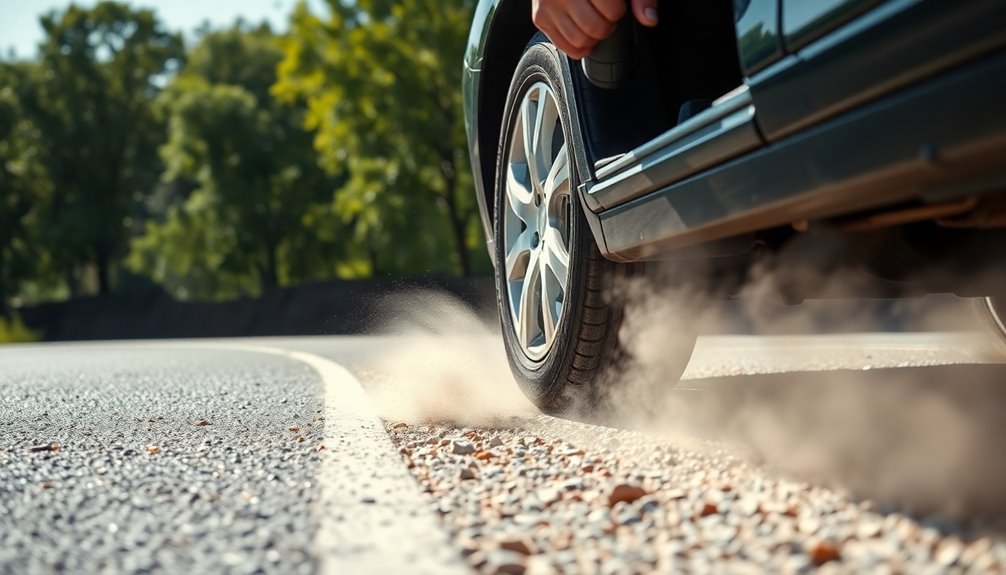If you run your right or left wheels off the road, the first thing you should do is stay calm and gently ease off the accelerator. This helps you maintain control. Keep a firm grip on the steering wheel and avoid any sudden movements or sharp turns; these can lead to skidding. Gradually apply the brakes to slow down without stopping abruptly. Always assess your surroundings before steering back onto the road. By taking these smooth, calculated actions, you can regain control safely. There's a lot more to know about managing this scenario effectively, so keep exploring!
Key Takeaways
- Gradually ease off the accelerator to reduce your speed without abrupt movements.
- Maintain a firm grip on the steering wheel for better stability and control.
- Avoid sudden steering or sharp turns to prevent skidding.
- Gently apply the brakes to slow down gradually, avoiding hard stops.
- Stay calm and assess traffic conditions before attempting to return to the road.
Initial Response to Wheel Off Roadway

When you find yourself with your wheels off the roadway, it's vital to stay calm and act quickly. Your first step is to gradually ease off the accelerator. This helps reduce your speed without causing abrupt changes that could throw your vehicle out of control.
As you begin to slow down, maintain a firm grip on the steering wheel; this stabilizes your vehicle during the maneuver.
Next, assess the surrounding traffic conditions. Look for a safe moment to steer gently back onto the roadway. Avoid sharp turns, as they can easily lead to a skid, making it harder to regain control. Remember, the key is to steer smoothly, allowing your wheels to find traction on the road again.
It's important not to slam on the brakes during this process. Sudden braking can further increase the risk of losing control of your vehicle. Instead, focus on maintaining composure and executing your movements steadily.
Incorrect Actions to Avoid

Avoiding certain actions is essential when your wheels drift off the road. One critical mistake is abruptly steering back onto the pavement; this can lead to a skid and make you lose control of the vehicle. Instead, keep a steady grip on the steering wheel and avoid any sudden movements.
Slamming on the brakes is another harmful action. This can cause you to lose contact with the road, making it even harder to regain control. It's better to brake gently if necessary.
Don't come to a complete stop unless absolutely required; doing so can create a hazardous situation for you and other drivers. Continuing to drive off the pavement without attempting to regain control is also risky and could lead to further complications or accidents.
Additionally, avoid accelerating quickly in an attempt to regain control, as this might exacerbate the loss of traction and stability. Instead, ease off the accelerator and allow your vehicle to stabilize.
Expert Verified Recommendations

When your wheels run off the road, it's crucial to focus on gradual speed reduction and controlled steering techniques.
You'll want to prioritize safety by evaluating your surroundings before making any moves.
Following these expert recommendations can help you regain control and return to the roadway safely.
Gradual Speed Reduction
How can you safely reduce your speed if you find your wheels off the road? The key is to implement a gradual speed reduction. Start by gently easing off the accelerator. This allows you to reduce speed without losing control of the vehicle. Maintaining a low speed is essential for stabilizing your car and regaining traction.
Avoid sudden braking, as this can lead to skidding or a complete loss of control, especially on loose surfaces. Instead, focus on gentle steering adjustments. Quick or sharp turns can cause overcorrection, increasing the risk of skidding.
Here's a quick reference table to help you remember the essential steps:
| Action | Purpose | Emotion |
|---|---|---|
| Ease off accelerator | Gradual speed reduction | Calmness |
| Avoid sudden braking | Maintain control | Safety and confidence |
| Gentle steering | Prevent skidding | Control and focus |
| Stay patient | Regain traction | Peace of mind |
Following these recommendations enhances safety and greatly increases your chances of safely returning to the roadway. Stay calm and in control, and you'll navigate this situation more effectively.
Controlled Steering Techniques
After reducing your speed, the next step is to focus on controlled steering techniques. These techniques are vital for regaining control of your vehicle and safely guiding back onto the road.
Here are some expert recommendations to keep in mind:
- Maintain a firm grip on the steering wheel to guarantee stability.
- Gently apply the brakes to avoid sudden stops that can lead to skidding.
- Assess the situation around you before making any maneuvers.
- Steer gradually back onto the roadway when it's safe, steering smoothly rather than making abrupt movements.
- Avoid sharp turns that can cause overcorrection and worsen your situation.
Safety Prioritization Steps
Safety should always be your top priority if you find your vehicle's wheels off the road. The first action you should take is to gradually ease off the accelerator. This helps reduce your speed without making any abrupt movements, which can lead to losing control. Firmly grip the steering wheel to maintain control; sudden jerking motions can cause skidding.
Next, gently apply the brakes to slow down. Avoid slamming them, as this could result in a loss of traction, especially on loose surfaces. While doing this, evaluate the roadway conditions around you. Only when it's safe, and there's no oncoming traffic, should you steer back onto the pavement.
Staying calm is essential throughout this process. Panic can lead to dangerous overcorrections or a further loss of control, increasing the risk of an accident.
Common Misconceptions

Many drivers hold misconceptions about the best actions to take when their wheels run off the road. It's essential to understand that reacting impulsively can worsen the situation. Here are some common misconceptions to be aware of:
- Stopping quickly is the best response.
- Immediately steering back onto the pavement is safe.
- Slamming on the brakes prevents loss of control.
- Coming to a complete stop is necessary to regain traction.
- Accelerating rapidly helps regain control.
When your front tires lose contact due to running off the pavement, the safest approach is to maintain a slow speed.
Instead of panicking, brake gently to avoid skidding. Avoid the common misconception that you should jerk the wheel and steer back onto the road immediately; this can lead to overcorrection and accidents.
Instead, gently steer back onto the road once you feel you've regained some control.
Managing Vehicle Control

When your wheels run off the road, the first step is to gradually ease off the accelerator to slow down.
Keep a steady grip on the steering wheel and avoid any sudden movements to maintain control.
Once it's safe, gently steer your vehicle back onto the road, ensuring smooth adjustments to prevent skidding.
Gradual Speed Reduction
If you find yourself running your wheels off the road, easing off the accelerator is essential to regain control. Gradually reducing your speed helps maintain stability without causing abrupt changes that could lead to loss of control.
Here are some steps to follow:
- Maintain a firm grip on the steering wheel to keep your vehicle steady.
- Avoid slamming on the brakes, as this increases the risk of skidding or rolling over, especially on unstable surfaces.
- Lightly apply the brakes if necessary, but do it gently to avoid sudden stops that destabilize your vehicle.
- Assess your situation while maintaining a controlled speed; this will help you decide your next move back onto the roadway.
- Steer smoothly in the direction you want to go, avoiding sharp turns that may lead to overcorrection.
Steer Back Carefully
After gradually reducing your speed, the next step is to steer back onto the roadway carefully.
Hold the steering wheel firmly to maintain control of your vehicle. As you assess the situation, keep a calm demeanor; this helps you make rational decisions. When it's safe, gently steer back onto the roadway. Avoid sudden or sharp turns, as these can lead to a loss of control.
If necessary, lightly apply the brakes to further manage your speed.
However, be cautious with hard braking, especially on loose or slippery surfaces, as this could cause skidding. Easing off the accelerator is essential; you want to slow down smoothly without abrupt movements.
Avoid Abrupt Movements
Maintaining control of your vehicle is essential when your wheels run off the road, and avoiding abrupt movements is a key part of that process. Sudden actions can lead to overcorrection and compromise your stability.
Here's what you should keep in mind:
- Avoid sudden steering movements to prevent losing control.
- Gradually release the gas pedal to reduce speed smoothly without abrupt stops.
- Brake gently to maintain traction and prevent skidding on unstable surfaces.
- Steer back onto the roadway slowly and carefully to guarantee your vehicle remains stable.
- Stay calm and composed to make rational decisions and manage your vehicle's trajectory effectively.
Understanding Skid Types

Understanding the various types of skids is essential for any driver looking to maintain control on the road. A skid can occur for several reasons, primarily related to the loss of traction in either the front or rear tires.
Here's a quick overview of common skid types:
| Skid Type | Description |
|---|---|
| Understeer | Front tires lose traction, causing the vehicle to go straight despite attempts to turn. |
| Oversteer | Rear tires lose contact, causing the back to swing out, potentially leading to a spin. |
| Fishtailing | Alternating oversteer creates cyclical skids, making control difficult. |
| Spin Out | Uncontrolled rotation of the vehicle, often resulting in a loss of control. |
To manage these skids, you need to react appropriately. If you experience understeer, try to brake gently and gently steer the vehicle. In the case of oversteer, counter-steering can help regain control. Always remember that the key is to stay calm and avoid abrupt movements, as this can worsen the situation. Understanding these skids will help you maintain better control of your vehicle in challenging conditions.
Evasive Actions for Safety

Executing evasive actions quickly and calmly is vital when you find yourself running off the road. Your first action should be to gradually ease off the accelerator, reducing your speed without making any abrupt movements. Firmly hold the steering wheel to maintain control, as sudden steering can lead to loss of traction or skidding.
Next, gently apply the brakes to slow down gradually. Slamming on the brakes could cause skidding, especially on loose surfaces.
Once you've slowed down, it's important to assess the situation before making any moves. Check for oncoming traffic, road conditions, and the space available for re-entering the roadway.
When it's safe, steer back onto the roadway smoothly, avoiding sharp turns that could compromise your control. Throughout this process, remember to stay calm. Panic can cloud your judgment and lead to poor decisions.
Here's a quick summary of your evasive actions:
- Gradually ease off the accelerator.
- Firmly hold the steering wheel.
- Gently apply the brakes.
- Assess the situation.
- Steer back onto the roadway when safe.
Stay focused, and you'll regain control effectively.
Additional Resources and Support

After regaining control of your vehicle, it's important to know where to turn for help and information. Community forums are a great resource for peer support, where you can connect with other drivers who've faced similar situations. By sharing experiences, you can gain valuable insights on how to handle off-road incidents effectively.
Look for expert explanations available online that clarify best practices for maintaining vehicle control after running off the road. These resources can help you understand the proper techniques to regain stability. Additionally, step-by-step guides can provide immediate assistance, reinforcing safe driving behaviors in various scenarios.
Don't overlook the convenience of mobile apps, which can quickly scan for information related to driving safety and off-road situations. These apps often offer tips and resources at your fingertips, making it easier to stay informed while on the go.
Frequently Asked Questions
What Is the First Thing to Do if You Run Your Right or Left Wheels?
If you find yourself with your right or left wheels off the road, your first step is to stay calm.
Gradually ease off the accelerator to slow down without abrupt actions. Grip the steering wheel firmly and assess your surroundings.
When it's safe, gently steer back onto the roadway, avoiding sharp turns. Remember, don't slam on the brakes, as this can lead to losing control or causing an accident with vehicles behind you.
What Is the First Thing You Should Do if You Run Your Right or Left Wheels off the Roadway in Quizlet?
If you ever find yourself with your wheels off the roadway, remember to stay calm and focused.
Ease off the accelerator, grip the steering wheel firmly, and steer straight. Avoid sudden movements that could cause skidding. Instead of slamming on the brakes, gently apply them if needed.
Assess your surroundings and look for a safe spot to guide your vehicle back onto the road without making abrupt turns. Staying composed is key.
What Steps Should You Take if You Run off the Road?
If you run off the road, start by easing off the accelerator to slow down gradually.
Keep a firm grip on the steering wheel and steer straight to maintain control.
Avoid sudden movements or sharp turns to prevent skidding.
If necessary, gently apply the brakes, but don't slam them.
Look for a safe spot to steer back onto the road, ensuring it's clear of obstacles and other vehicles.
Stay calm throughout the process.
What Should You Do if Your Right Wheels Go of the Pavement While Driving?
If your right wheels go off the pavement while driving, don't panic.
Start by easing off the accelerator to slow down gradually. Keep a firm grip on the steering wheel to maintain control, avoiding any sudden movements.
Check your surroundings for traffic, and once it's safe, steer gently back onto the road.
Conclusion
When you find yourself with a wheel off the road, remember to stay calm and gently steer back, like a sailor adjusting their sail to catch the wind. Panic can lead to a crash, just as a hasty turn can capsize a boat. Studies show that over 70% of drivers successfully regain control when they respond thoughtfully. So, take a deep breath, focus, and steer back to safety. Your smooth journey depends on it!









